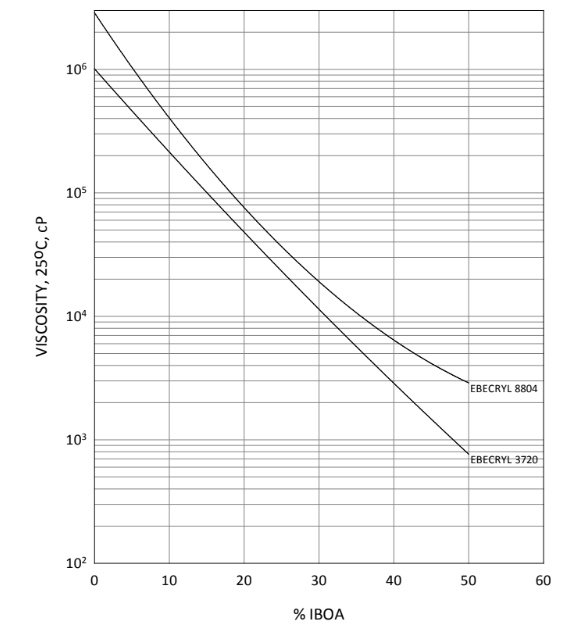Enhanced TDS
Identification & Functionality
- Blend
- No
- CASE Ingredients Functions
- Chemical Family
- Chemical Name
- Country of Origin
- Function
- Reactive Diluent
- Product Code
- MITM00483
- Single Ingredient
- Yes
- Synonyms
- exo-1,7,7-Trimethylbicyclo[2.2.1]hept-2-yl acrylate, exo-Isobornyl acrylate
- Technologies
- Product Families
Features & Benefits
- CASE Ingredients Features
- Product Performance
IBOA is characterized by:
- Low viscosity
- Wide range of compatibility with oligomers
- Low color
UV/EB curable formulated products containing IBOA are characterized by:
- Good flexibility
- Increased Tg, thermal resistance
- Low shrinkage
- Improved water resistance
Applications & Uses
- Coating End Applications
- Compatible Polymers & Resins
- Cure Method
- Product Applications
IBOA can be used in UV/EB curing formulations to provide significant viscosity reduction while maintaining both hardness and flexibility.
IBOA is recommended for:
- Coatings requiring flexibility with hardness & thermal resistance.
- Maintaining high elongation in urethane acrylates.
- Screen inks and coating requiring increased adhesion to polyolefins.
Technical Details & Test Data
- Technical Data
Viscosity Reduction
Graph I shows the viscosity reduction of two EBECRYL® oligomers when blended with an increasing weight percent of IBOA. EBECRYL® 3720(1) is a bisphenol A based epoxy diacrylate. EBECRYL® 8804(1) is an aliphatic urethane diacrylate.Graph I
IBOA - Diluency Effect on Viscous Oligomers
Packaging & Availability
Principal Information
- Group Principal Number
- S000001
- Principal
Storage & Handling
- Storage Conditions
- Storage and handling should be in stainless steel, amber glass, amber polyethylene or baked phenolic lined containers.
- Procedures that remove or displace oxygen from the material should be avoided.
- Do not store this material under an oxygen free atmosphere.
- Dry air is recommended to displace material removed from the container.
- Wash thoroughly after handling.
- Keep container tightly closed.
- Use with adequate ventilation.
- Handling Information
- Care should be taken not to expose the product to high temperature conditions, direct sunlight, ignition sources, oxidizing agents, alkalis or acids.
- This might cause uncontrollable polymerization of the product with the generation of heat.
Other
- Appearance
- Clear liquid
- Appearance (SDS)
- Liquid
- Color (SDS)
- Clear colorless
- IATA/ICAO Proper Shipping Name
- ENVIRONMENTALLY HAZARDOUS SUBSTANCE, LIQUID, N.O.S
- IATA/ICAO Technical name (N.O.S.)
- Isobornyl acrylate
- IATA/ICAO UN Number
- UN3082
- IMO/IMDG Proper Shipping Name
- Isobornyl acrylate
- IMO/IMDG Technical name (N.O.S.)
- ENVIRONMENTALLY HAZARDOUS SUBSTANCE, LIQUID, N.O.S
- IMO/IMDG UN Number
- UN3082
- Item Number
- Odor (SDS)
- Ester
- Other Hazards
- Polymerization may occur from excessive heat, contamination or exposure to direct sunlight.
- Protect from Freezing
- Yes
- TDG Canada Proper Shipping Name
- ENVIRONMENTALLY HAZARDOUS SUBSTANCE, LIQUID, N.O.S.
- TDG Canada Technical name (N.O.S.)
- Isobornyl acrylate
- TDG Canada UN Number
- UN3082
- Temperature Control
- Yes
- Chemical Properties
Value Units Test Method / Conditions Assay min. 98.5 % % Total Acidity max. 0.25 %(W/W) %(W/W) Acrylic Acid - Material Composition
Value Units Test Method / Conditions Butylated Hydroxytoluene Content 80.0-130.0 ppm ppm - Optical Properties
Value Units Test Method / Conditions Color Scale max. 50.0 Pt-Co Pt-Co - Physical Properties
Value Units Test Method / Conditions Density 0.97 g/mL g/mL at 25°C Flash Point min. 100.0 °C °C SetaFlash Closed Cup Melting Point max. -35.0 °C °C Storage Temperature 39.2-104.0 °F °F - SDS Physical and Chemical Properties
Value Units Test Method / Conditions Autoignition Temperature (SDS) 390.0 °C °C Boiling Point (SDS) min. 250.0 °C °C Flash Point (SDS) min. 100.0 °C °C Closed Cup Log Partition Coefficient (Log Pow) (SDS) 2.4 - n-Octanol/Water Melting Point (SDS) max. -35.0 °C °C Self Accelerating Polymerization Temperature (SDS) min. 75.0 °C °C Solubility In Water (SDS) max. 50.0 mg/L mg/L at 20°C Specific Gravity (SDS) 0.972 - Vapor Pressure (SDS) 0.013 hPa hPa at 25°C Viscosity (SDS) 10.0-15.0 mPa.s mPa.s at 25°C - Shelf Life & Stability
Value Units Test Method / Conditions Shelf Life 365.0 d d
